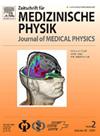Gamma radiation detector selection for CT scanner
IF 4.2
4区 医学
Q2 RADIOLOGY, NUCLEAR MEDICINE & MEDICAL IMAGING
引用次数: 0
Abstract
Three types of gamma radiation detectors associated with distributed electronics namely, NaI (Tl), HPGe and are compared primarily focusing on electronic noise and scattering noise. Additionally, detectors of same make, material, size and electronics are also compared. A methodology is proposed to select the most suitable detector for computed tomography (CT) among the available options. Standard deviation parameter is employed to estimate electronic noise without performing CT experiment. Kanpur theorem-1(KT-1) is used to estimate the scattering noise quantitatively after verifying its sensitivity to scattering noise. The impact of scattering noise on CT profiles is evaluated using dice similarity dice coefficient. A good resemblance between KT-1 and dice coefficient is observed. A maximum difference of 56% in scattering noise is observed when five detectors used simultaneously instead of single detector whereas a discrepancy of 85% is observed between different types of radiation detectors. As far as ease of handling, operational and capital cost is concern one has to compromise minimum 12% of accuracy in CT reconstruction if NaI (Tl) detector is used with respect to best alternative available.
The proposed methodology can be applied to measurement that require minimal scattering interference data other than CT experiments. The manufacturer can add noise level of detector as a characteristic parameter in the data sheet.
CT扫描仪伽玛辐射探测器的选择
比较了三种与分布式电子学相关的伽马辐射探测器,即NaI (Tl)、HPGe和LaBr3(Ce),主要关注电子噪声和散射噪声。此外,还对相同制造、材料、尺寸和电子器件的探测器进行了比较。提出了一种方法,以选择最合适的检测器的计算机断层扫描(CT)中可用的选项。在不进行CT实验的情况下,采用标准差参数估计电子噪声。在验证了Kanpur定理1(KT-1)对散射噪声的敏感性后,利用Kanpur定理1对散射噪声进行了定量估计。利用骰子相似系数评价了散射噪声对CT轮廓的影响。观察到KT-1和骰子系数之间有很好的相似性。同时使用5个探测器而不是单个探测器时,散射噪声的最大差异为56%,而不同类型的辐射探测器之间的差异为85%。考虑到操作、操作和资金成本,如果使用NaI (Tl)检测器作为最佳替代方案,则必须在CT重建中牺牲至少12%的准确性。该方法可应用于CT实验以外的散射干扰最小的测量。制造商可以在数据表中添加探测器的噪声级作为特征参数。
本文章由计算机程序翻译,如有差异,请以英文原文为准。
求助全文
约1分钟内获得全文
求助全文
来源期刊
CiteScore
3.70
自引率
10.00%
发文量
69
审稿时长
65 days
期刊介绍:
Zeitschrift fur Medizinische Physik (Journal of Medical Physics) is an official organ of the German and Austrian Society of Medical Physic and the Swiss Society of Radiobiology and Medical Physics.The Journal is a platform for basic research and practical applications of physical procedures in medical diagnostics and therapy. The articles are reviewed following international standards of peer reviewing.
Focuses of the articles are:
-Biophysical methods in radiation therapy and nuclear medicine
-Dosimetry and radiation protection
-Radiological diagnostics and quality assurance
-Modern imaging techniques, such as computed tomography, magnetic resonance imaging, positron emission tomography
-Ultrasonography diagnostics, application of laser and UV rays
-Electronic processing of biosignals
-Artificial intelligence and machine learning in medical physics
In the Journal, the latest scientific insights find their expression in the form of original articles, reviews, technical communications, and information for the clinical practice.

 求助内容:
求助内容: 应助结果提醒方式:
应助结果提醒方式:


